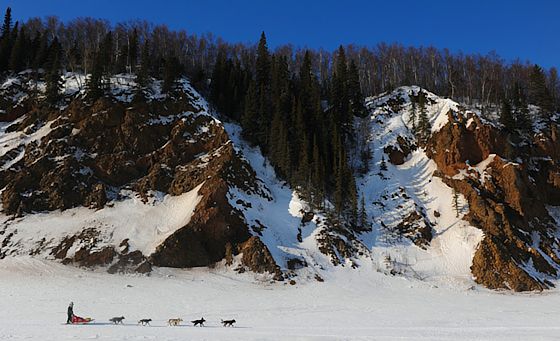Anvik is a Deg Hit’an Athabascan community, with a rich history. It is located on the west bank of the Yukon River in Interior Alaska, just inside the old mouth of the Anvik River along the hillside. This hillside is called Deloy Ges (Hawk Bluff is the English name), which means “so-called mountain” in Deg Xinag, the local Athabascan language. Raven, or Yuxgitsiy, whose name translates as “everyone’s grandfather” created Deloy Ges.
Sub-Arctic Tribes
Sub-Arctic Tribes
Location: Most of present-day Canada and most of Interior, Western and South Central Alaska
>>Long cold winters with heavy snowfall. >>Northern Forest of evergreen pine and fir trees, a few deciduous trees like birch and willows. >>Numerous lakes and rivers
The Subarctic regions of the Americas are located south of the true Arctic. This region includes the interior of Alaska, the Western Subarctic or western Canadian Shield and Mackenzie River drainage area, and the Eastern Subarctic or Eastern Canadian Shield. Peoples of subarctic Siberia and Greenland are sometimes included in the subarctic; however, Greenlandic Inuit are usually classified as Indigenous peoples of the Arctic. See Alaskan Natives A to Z for information specific to individual federally recognized tribes or villages in Alaska, which may not apply to all tribes who share their culture group. The subarctic climate (also called a boreal climate) is characterized by long, usually very cold winters, and short, cool to mild summers. It is mostly found on large land masses, away from the moderating effects of an ocean.With 5–7 consecutive months where the average temperature is below freezing, all moisture in the soil and subsoil freezes solidly to depths of many feet. Summer warmth is insufficient to thaw more than a few surface feet, so permafrost prevails under most areas not near the southern boundary of this climate zone. Seasonal thaw penetrates from 2 to 14 ft (0.61 to 4.27 m), depending on latitude, aspect, and type of ground. Some northern areas with subarctic climates located near oceans in southern Alaska have milder winters and no permafrost, and are more suited for farming unless precipitation is excessive. The frost-free season is very short, varying from about 45 to 100 days at most, and a freeze can occur during any month in many areas.Vegetation in regions with subarctic climates is generally of low diversity, as only hardy species can survive the long winters and make use of the short summers. Trees are mostly limited to conifers, as few deciduous trees are able to survive the very low temperatures in winter. This type of forest is also known as taiga. Even though the diversity may be low, numbers are high, and the taiga (boreal) forest is the largest forest biome on the planet, with most of the forests located in Russia and Canada.Native subarctic peoples have over 30 languages, falling into two major language families: Algonquian and Athapaskan. Algonquian peoples tend to live in the east, while Athapaskan peoples live more in the west.Caribou has traditionally played a central role in Subarctic culture. Besides providing food, the caribou provide clothing, shelter, and tools, such as the babiche bag, made of caribou rawhide. Moosehair embroidery and porcupine quill embroidery are worked onto hides and birchbark. After introduction by Europeans, glass beads became popular and are sewn into floral designs. Some cultures practice limited agriculture, alongside hunting and gathering.
Subarctic Tribes
Ahtna (Ahtena, Nabesna)
Anishinaabe (see also Northeast Woodlands, Plains Indians)
Oji-Cree (Anishinini, Severn Ojibwa) Ontario, Manitoba
Ojibwa (Chippewa, Ojibwe), Ontario, Manitoba, Minnesota
Atikamekw
Babine
Bearlake
Carrier
Chipewyan
Chilcotin
Cree
Dakelh
Babine
Wet’suwet’en
Degexit’an (Ingalik)
Deg Hit’an (Deg Xinag, Degexit’an, Kaiyuhkhotana)
Dena’ina (Dialects: Outer Inlet, Upper Inlet, Iliama, Inland, Kachemak Bay, Kenai, Susitna River)
Dogrib
Dunneza (Beaver)
Gwich’in (Kutchin, Loucheaux)
Han
Hare
Holikachuk
Innu
Kaska (Nahane)
Kolchan (Upper Kuskowim)
Koyukon
Kutchin
Mountain
Naskapi
Nishka
Ojibwa
Sekani
Slavey (Dialects: Hay River, Simpson Providence, Liard, Fort Nelson)
Tagish
Tahltan
Lower Tanana
Middle Tanana
Upper Tanana
Tanacross
Tanaina (Dialects: Outer Inlet, Upper Inlet, Iliama, Inland, Kachemak Bay, Kenai, Susitna River)
Tasttine (Beaver)
Inland Tlingit
Tsilhqot’in (Chilcotin)
Tsetsaut (extinct)
Tsimishian
Northern Tutchone
Southern Tutchone
Wet’suweten
Yellowknife
Arctic
California
Northeast
Great Basin
Great Plains
NW Coast
Plateau
Southeast
Southwest
Sub Arctic
